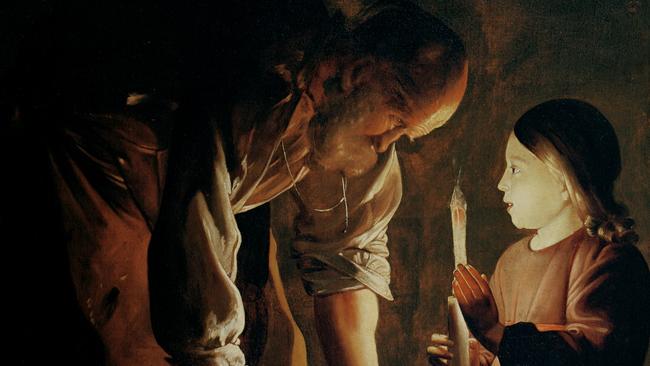Blessed transformation of the paternal instinct
Statistics show that fathers have become much more present in family life and, above all, more intimately engaged with their children.

The greatest social change in Western countries such as Australia in the last half-century has arguably been the narrowing gender gap in public roles.
The patriarchal bias that dominated work, public office, and creative performance has slowly and steadily been corrected. One unforeseen positive consequence of this correction has been the changing nature of fatherhood.
The 21st century has witnessed the new and historically quite unprecedented phenomenon of fathers walking along urban footpaths on weekdays carrying pouches with babies snuggled into them, or steering pushers.
As indicator of a new normality, there was the recent image of James Bond actor Daniel Craig carrying his baby in a front pack in New York — a sign of changing notions of masculinity, itself of current topical interest.
Recent Australian Bureau of Statistics figures show that 30 per cent of fathers take advantage of flexible hours to look after young children, double the percentage of two decades ago.
Fathers have, in general, become much more present in family life and, above all, more intimately engaged with their children. This has reflected not just a transformation in social and cultural attitudes but some development in the psychic quality and meaning of the paternal bond.
The 1950s symbolised the old order, as highlighted in the insightful US television series Mad Men. Husbands and fathers were largely absent, at work during the week and at sport on Saturdays, either participating or watching. Their role as breadwinner, and as the family member who was competent and confident in the public sphere, underlined their position as head, with the inflection of superior power and authority.
Wives and mothers ruled the house — their domain. There was a necessary division of labour.
First, Western economies had not yet developed and expanded enough, as they would in the following decades, to provide large-scale employment for both men and women. Second, whitegoods that would radically reduce the time-consuming drudgery of running a household were only just appearing.
This was vividly illustrated in the excellent 2018 ABC TV social history, Back in Time for Dinner, a seven-part series hosted by Annabel Crabb, in which changing family life in Australia was re-enacted, with each episode devoted to a particular decade. The most striking moment in the entire series for me was the depiction of the start of the first decade, the 50s — a truly different world.
Before the advent of the washing machine, the housewife had to spend dull, backbreaking hours boiling, hand-scrubbing and wringing clothes — every day.
The supermarket and the home refrigerator were both yet to arrive, so the buying and storing of food posed acute challenges.
Before the electric vacuum-cleaner, dusting and mopping brought their own trials in labour.
In the ABC series, the woman who had been cast as the 50s housewife reflected on her experience as being an ordeal of unrelenting drudgery.
Nevertheless, and despite appearances to the contrary, this division of labour along strict gender lines was more a product of culture than practical necessity.
There was no reason women couldn’t have played a larger role in the workforce, as they had during both world wars; the men could have worked part-time.
In my own 50s family, my father had flexible enough work hours to do school drop-offs and pick-ups and spend more time at home with children — but he didn’t, because that would have been unthinkable in the culture of the day. That was just not what you did.
He would spend all Saturday at golf, without giving a second thought to the potential damage to family life.
It needs to be kept in mind that judging the past from today’s perspective is unbalanced. The 50s was, assessed by any realistic historical standards, a decade of peace and prosperity, following two generations of world war and depression — most had never had it so good, as British prime minister Harold Macmillan intoned.
The time was the golden age for children growing up in Australian suburbia — of open and free, unfettered happiness, with regular excursions to beach and country in the newly available, and affordable to most, family car. Clive James captures the joy of growing up near Botany Bay in Sydney in that period, in his autobiography Unreliable Memoirs.
There was, however, a dark side to new postwar prosperity, and the seemingly stable suburban marriage, as it was lived behind the white picket fence.
Feminist writing that emerged in the 60s put the case. John Brack’s starkly caricatured 1955 painting Collins St, 5pm, illustrated one dimension: a robotic troop of grim-faced, expressionless men, in suits and hats (and a few women), all looking alike, march ant-like to the station and then off home to the suburbs. According to Brack’s image, the men of the time fared no better than their wives.
Mad Men shows the estrangement. Father escapes into work, his one passion. He drifts into aimless love affairs and he remains distant from his own children, with whom he shares little affinity. Mother is depressed, feeling unloved, and trapped despairingly in her comfortable suburban house. Restless and bored, she too has little affinity with her children. It is a cold, dysfunctional family.
Since the 50s, there has been a steady transformation in the behaviour of fathers. This reflects a strengthening of the ideal of the companionate marriage, which itself is far from new, going through historical cycles since its early appearance in Elizabethan England.
Then, the new Protestant view saw everyone, irrespective of gender, as equal before God.
From this revolutionary perspective — fundamental to democracy — derived the belief in husband and wife as equals, companions, helping each other along life’s path, and especially in the raising of children.
The Protestant emphasis on companionship contrasted with the Catholic stress on chastity.
The companionate marriage achieved its paradigm literary expression at the end of the 18th century in Jane Austen’s novels, and especially in Pride and Prejudice — which pictured the coming together of two singular, strong-willed, intelligent, discriminating characters who find, in the end, that they are made for each other.
Their match was enabled, in the English aristocracy, by the wealth enjoyed by a leisured class. Servants did the housework.
The continuing popularity of Jane Austen, in film and television adaptation, shows the enduring appeal of the male-female ideal she espouses.
Switching back to recent times, there has been resistance to the emerging form of the companionate marriage and its family.
The super-masculinity of the American western hero of the 50s, exemplified by John Wayne and his successor Clint Eastwood, at times came across as a last-ditch stand and a protest against changing roles.
In the Academy Award winning mainstream, The Godfather, from 1972, stood as a partly nostalgic throwback to a world in which order was kept and community protected by the deeply authoritative and paternal mafia boss — alternating affectionate benevolence with ruthless viciousness.
Thirty years later The Sopranos continued the glamorisation of charismatic, yet sadistic, male gangster power, if now with much greater ambivalence.
And through the decades, celebrations of the ultra-masculine hero abound — to name a few, Superman, Rocky, Braveheart, Gladiator, and Batman.
One of the West’s great social achievements has been the discovery of the companionate marriage as the most fulfilling way, for most, to conduct adult human relations and to bring up children.
This has depended on a slow change over many generations from the standard pre-modern family pattern, in which fathers disciplined and mothers nurtured. In the ideal contemporary family, both parents combine authority and nurture.
Even over the past 70 years we have seen an evolution, with the standard father becoming far more nurturing than his 50s predecessor. The new father delivers children to school, attends functions there, gets to know teachers, and joins parental gatherings — themselves forms of community that reinforce the shared bonds across generations. At home, he changes nappies, plays with his children and reads to them at night. Other domestic roles too have broadened, with him more likely to share cooking, shopping, entertaining and cleaning duties.
This has meant children are less likely to see their parents — both of them — as culturally remote, separated by a chasm of generational difference. Friendship across the generations has become more likely, with the children sharing a common view of the world with their parents.
But this profound social change is not enough on its own to bring a deeper meaning to the role of father — or of mother, for that matter. Any serious relationship needs an archetype to anchor it — a mythic story.
That anchor is to a timeless motif or deeper cultural narrative that makes of the relationship something more than what passes fleetingly in the mundane here and now — investing it with connection and responsibility. Let me illustrate in the case of the father.
In our Western tradition most of the archetypal stories come out of classical Greece and the Bible.
In the case of Christianity, the presiding paternal image is God the Father — all-powerful, all-knowing and usually benevolent. But the extremity of the gender bias implied here is not much use as a model for the human family — serving at best as a dated metaphor for pre-modern patriarchy.
Within the holy family of Jesus, Mary, and Joseph, Joseph was a marginal figure, his fatherhood in doubt, given that his pregnant wife was reputed to be a virgin.
His potency had been usurped by a more powerful sacred force, whether angel, Holy Spirit, or God. In Renaissance art, Joseph was often portrayed as an ineffectual and dim-witted older man. The story celebrates mother and son, to the virtual exclusion of the human father, who lurks awkwardly in the background.
In later retellings of the story of the primary holy family, there have been exceptions to the marginalising of the father.
Most notably, the French 17th-century painter Georges de la Tour produced a small work of iconic intensity and beauty, Saint Joseph the Carpenter, today housed in the Louvre. Here, Joseph is projected as a modest, troubled paradigm of the father. He doubles up as any father, indeed every father, but also the father of Jesus.
It is night — the scene is dark and gloomy. Joseph stands bent double over a beam into which he bores a hole with his gimlet, the precursor to the drill — he is a carpenter. His huge form in the shadows takes up half the surface of the painting. On the right, his son — seven years old maybe, or a little more — holds a candle to light his father’s work. The flame flares up unnaturally long and bright. The boy Jesus’ face is brilliantly illuminated. The father looks down with frenzied concentration. He works as if his life depended on it.
Why? In the darkness of the floor we see the clue. What he is making is the cross.
Joseph exemplifies unconscious knowing — knowing something instinctively, but not being conscious of that knowledge.
If he did know the future truth — his dear son tortured to death by crucifixion — he would be paralysed. He would be turned to stone, for he is an ordinary man — indeed, he looks a very ordinary man. His vocation as the father of Jesus has as its highest element to meditate, through his trade, on the tragic climax of his son’s life, to come 25 years later.
Joseph’s vocation is a state of grace: it gives him access to the tragic destiny he was chosen to father. True vocation can be terrible. Who would choose to be Joseph?
He is beside himself with dreadful foreboding, only kept sane by his work. The important thing is to keep going, not close the eyes, stop in panic and flee; not pretend all is well. Death is not the deniable nothing that waits in the dim future.
The son gazes radiantly, smiling on his father’s work, looking up admiringly, but with worry, at his troubled brow. His left hand shades the candle to better illuminate his father and his task.
That hand is itself luminous, almost transparent, alluding to the nail that will be hammered into it.
The intimacy of son and father is steeped in tragedy. It is as if the son whispers to his father that all is well — I can bear this, so can you. Joseph’s vocation turns out to be that of father, rather than carpenter — likely much to his surprise, and he may not realise the fact.
One of the lessons taught by La Tour’s painting is that there is a law of fatherhood, one that sits in judgment on all fathers.
It goes something like: Thou shalt protect, guide and nurture, and this you will do irrespective of threat or competing duty. To fail in relation to this law is to suffer inevitable guilt — itself a sign that a law has been broken.
Joseph as father has his identity determined by his relationship with his son. In his case, nothing else really matters — not his trade, not his position in his local town community, whether or not he is a good citizen, nor whether he is otherwise a good man, and not even his role as husband.
The son knows this — which may be less extraordinary than we might think. The boy Jesus is exceptional, and yet not.
Children have their own kind of knowingness. Sons may stop in their helter-skelter rushing about, pause, and look wisely at their fathers, momentarily taking in the gravity of who they are. It is not different for daughters.
Joseph shows the possible intensity, momentousness, and intimacy of the bond between father and child. The closeness here of father and son is emblematic of the potential emerging for 21st-century fathers, who are more like him, the head of the original holy family, than was possible for their own fathers and grandfathers.
As they become a more integrated part of family life, rather than the background figure of earlier times, they will inevitably be seen through the eyes of their children as more richly complex figures than their forefathers.
This change is perhaps more developed in the upper middle class, which has managed to adjust its own necessary division of work/family labour in more composite ways to suit its revaluation of what suits it best.
This recent evolution within the companionate marriage is unambiguously better for everyone — father, child, and mother.
More vital personal relations are enabled, but not only that, as La Tour teaches. The great works of our culture reconnect us with whichever deep truths underpin our own particular roles, urging us to take them with more seriousness than we might otherwise, and urging us to reflect on them.
In the case of Joseph as father, it is as if an inner eye has been opened and he sees anew in the dark, put in metaphysical touch with the main thread of his life. He sees with a clarity and focus that might turn out to be redemptive.
John Carroll is professor emeritus of sociology at La Trobe University.



To join the conversation, please log in. Don't have an account? Register
Join the conversation, you are commenting as Logout